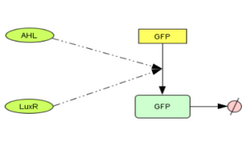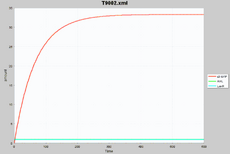IGEM:IMPERIAL/2006/project/Oscillator/project browser/Test Sensing Prey Construct/Modelling
From OpenWetWare
Jump to navigationJump to search
| Super Parts | Prey Construct | ||
|---|---|---|---|
| Actual Part |  T9002: Test Sensing Prey Construct | ||
| Sub Parts | F2620 | intermediate_part | intermediate_part |
Model assumptions and relevance
- General assumptions on gene expression modelling:
- Quasi-steady state hypothesis on mRNA expression.
- Gene activation can be approximated by Hill equations.
- Assumptions linked to the quorum sensing:
- As a first approximation, we assume that luxR and AHL molecules form a heterodimer (even if it has been found that the complex formed is more complicated)
- The relationship between the heterodimer formed from LuxR and AHL in activating genes is linear
- LuxR is at steady state since it is under the control of the constitutive promoter tetR
- LuxR is in excess of AHL (ie not saturated by AHL)
Model description
- Mathematical Description of GFP levels (prey sensitivity):
- [math]\displaystyle{ \frac{d[GFP]}{dt} = \frac{a \times [AHL]}{a_{0} + [AHL]} - d_{GFP} \times [GFP] }[/math]
- For a full derivation, see Modelling Prey Sensing Test Construct
 |
 |
Model variables and parameters
| Variables | ||||
| Name | Description | Initial Value | Confidence | Reference |
|---|---|---|---|---|
| AHL | Acyl Homoserince Lactone representing the prey molecule | Concentration Range varying between 0nM and 10uM | known | links |
| GFP | Green Fluorescent Protein to act as PoPs | 0 | to be measured | links |
| Parameters | ||||
| Name | Description | Value | Confidence | Reference |
|---|---|---|---|---|
| a | population-dependent | ? | to be extracted using experimental data | links |
| a0 | constant | ? | to be extracted using experimental data | links |
| dGFP | degradation constant due to GFP degradation (Half-life 45min.) | ? | to be extracted using experimental data | links |
Dynamical and sensitivity analysis
N/A
Characterization
- Describe how you plan to use the modelling to characterize the part